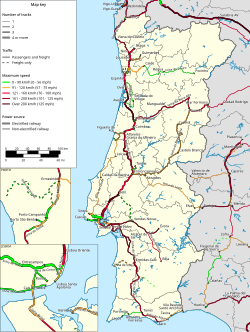| Portugal | |||||
|---|---|---|---|---|---|
 Alfa Pendular train, on the Northern Line | |||||
| Operation | |||||
| National railway | CP | ||||
| Infrastructure company | Infraestruturas de Portugal | ||||
| Major operators | CP, Fertagus, Medway - Transportes e Logística, Takargo Rail | ||||
| Statistics | |||||
| Ridership | 175.5 million (2019) [1] | ||||
| Passenger km | 4.1 billion (2018) [2] | ||||
| System length | |||||
| Total | 2,786 km (1,731 mi) | ||||
| High-speed | 593 km (368 mi) 21.2% of the network | ||||
| Track gauge | |||||
| 1,668 mm (5 ft 5+21⁄32 in) Iberian gauge | 2,603 km (1,617 mi) | ||||
| 1,000 mm (3 ft 3+3⁄8 in) metre gauge | 183 km (114 mi) | ||||
| Electrification | |||||
| 25 kV AC | Main network | ||||
| 1500 V DC | Linha de Cascais 25 km (16 mi) | ||||
| |||||
Rail transport in Portugal is provided mainly by Comboios de Portugal (CP), Portugal's national carrier, but also other operators. It includes high speed trains and rapid transit networks in Lisbon and Porto.
Contents
Portugal is a member of the International Union of Railways (UIC). The UIC Country Code for Portugal is 94.
There are rail links with Spain, which uses the same Iberian broad gauge. Some lines are in meter gauge.
